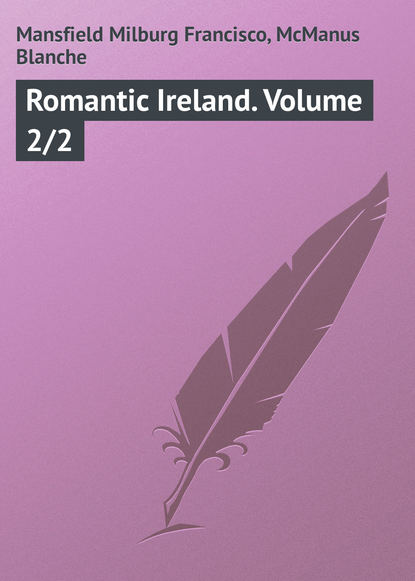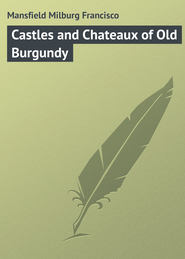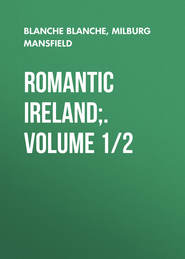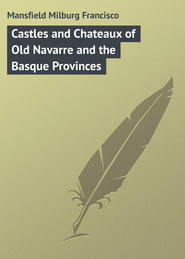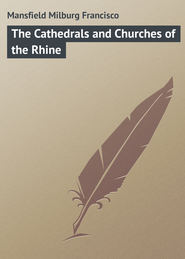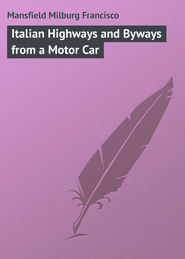По всем вопросам обращайтесь на: info@litportal.ru
(©) 2003-2024.
✖
Romantic Ireland. Volume 2/2
Настройки чтения
Размер шрифта
Высота строк
Поля
For here his cares he will entomb
And think no more of sorrow.
“Let Mallow yield to gay Macroom,
For here we know not care nor gloom,
Here nature wears perpetual bloom,
And quite dispels our sorrow.”
Near Macroom are the celebrated Inchigeela Lakes and the still more celebrated island and lake of Gougane Barra, the retreat of St. Finbarr, who had truly an eye for the beautiful and grand when he chose such a site as this for his meditations.
On the verdant islet are the ruins of the little church, and the arched praying-stations of the pilgrims to the shrine. A holy well is also here, and its primitive materials and rude masonry indicate, at a glance, the centuries that have passed since here dwelt the “Island Saint” and anchorite, the founder of Cork. Of the many venerable anchorites who afterward occupied the dwelling, and imitated the virtues of St. Finbarr, the last was Father Denis O’Mahony, whose tomb, erected by himself in 1700, is still to be seen.
Westward, near the border of the lake, is the “Green Valley of Desmond,” enclosed by towering mountains, from the side of one of which, “Nad-na-nillar” (the Eagle’s Nest), flows the tiny source of the river Lee, which runs through Cork to the sea. Here one fully appreciates the appellation, “Lone Gougane Barra.” Callanan, the native bard, has sung of it as follows:
“There is a green island in Lone Gougane Barra,
Where Allua of songs rushes forth as an arrow;
In deep-valleyed Desmond a thousand wild fountains
Come down to that lake from their home in the mountains.
There grows the wild ash, and a time-stricken willow
Looks chidingly down on the mirth of the billow,
As, like some gay child, that sad monitor scorning,
It lightly laughs back to the laugh of the morning.
And its zone of dark hills – oh! to see them all bright’ning
When the tempest flings out its red banner of lightning,
And the waters rush down, ’mid the thunder’s deep rattle,
Like clans from their hills at the voice of the battle.
And brightly the fire-crested billows are gleaming,
And wildly from Mullagh the eagles are screaming;
Oh, where is the dwelling in valley or highland
So meet for a bard as this lone little island!
…
Least bard of the hills, were it mine to inherit
The fire of thy harp, and the wing of thy spirit,
With the wrongs which like thee to our country has bound me,
Did your mantle of song fling its radiance around me.
Still, still in those wilds may young liberty rally,
And send her strong shout over mountains and valley,
The star of the west may yet rise in its glory
And the land that was darkest be brightest in story.
I, too, shall be gone, but my name shall be spoken
When Erin awakens, and her fetters are broken;
Some minstrel will come in the summer eve’s gleaming
When Freedom’s young light on his spirit is beaming,
And bend o’er my grave with a tear of emotion,
Where calm Avon Buee seeks the kisses of ocean,
Or plant a wild wreath from the banks of that river
O’er the heart and the harp that are sleeping for ever.”
CHAPTER II
GLENGARRIFF AND BANTRY BAY
TWO of the most famous men in English literature have passed unstinted praise on the beauty and charm of the southern Irish coast.
If one looks at a map of the southwest of Ireland, it will be seen that its whole coast-line is broken into serrations, making harbours, islands, bays, and coves. If he should go to the coast itself, he will have revealed to him a wondrous kaleidoscope, – alternate scenes of sweet, pathetic gentleness, and stern and rugged grandeur, all full of engrossing charm.
Leaving the coast and going inland, as there is every facility for doing, one finds the finest lakes in the United Kingdom; and, if there are no Mont Blancs or Matterhorns, there are, at least, beautiful hills and mountains with no less charm and none of their difficulty of access. The great Atlantic waves beat against the wild rocks of the south Irish coast; but the Gulf Stream gives warmth of an almost subtropical mildness to the fresh sea air, and the lowlands are enriched by the soft rains which wash the hills and fall into the great arms of the sea, called Bantry Bay, Kenmare River, and Dingle Bay.
Farther north is the ample estuary of the river Shannon and Galway Bay, each with much the same characteristics. To take a steamer from Cork for a tour of the southwest coast will form a unique experience in the itinerary of most folk. Rounding Cape Clear, the small coasting-steamer makes the first stop at the little village of Schull, which stands at the farther extremity of an almost landlocked bay. Here the land on three sides gently shelves to low ranges of verdant hills, while the harbour is speckled with its fishing craft.
Leaving Schull, a half-hour or more is passed before we are clear of the many rocky islands of its harbour and come to a view of Brow Head, with its signal-station. Mizen Head and Sheep’s Head are seen in their turn; and the dawn finds the ship snugly anchored at Berehaven. Here at Castletown-Berehaven we are at the home station of the Channel fleet during the autumn manœuvres. Before us is the grand panorama of Glengarriff and the mountains which shelter Killarney’s lakes; while seaward is only the vast surge of the Atlantic.
The splendid bay of Bantry, which takes its name from the town which lies sheltered at its head, is unsurpassed as a harbour and roadstead throughout the world. Here the sturdy Atlantic swell, blue as sapphires, rolls in great lashes of foam; and Berehaven, just inside the Bear or Bere Island, is the base of the yearly autumn manœuvres of the English Channel fleet. From any view-point this rugged, walled bay is more than impressive, – more impressive, even, than Glengarriff itself, which lies still farther inland, its circumference dotted with weed-embroidered boulders. Bantry Bay is twenty-one miles in length; from three to five in width; and has a depth, in parts, as great as 220 feet. Berehaven and Castletown, which are nearest the open sea, lie just inside a jagged fang, which, once rounded, opens up an obscure aperture in the coast-line, and discloses a harbour in which, truly, all the fleets of the world might lie at anchor.
Twice the French fleet invaded Bantry Bay. The first time, in 1689, in aid of James II.; and the second, in 1796, by the ill-favoured expedition organized by General Hoche, when the Surveillante was engulfed, and the foe-laden fleet ultimately took their departure without disgorging their army. This latter fleet, which had been arrayed for the invasion of Ireland by Carnot and Clarke, with Theobald Wolfe Tone as the organizer of the Irish Republicans, consisted of twenty-six sail, with a force of nearly seven thousand men. The O’Sullivans were the ancient chieftains or princes of this territory; and, to-day, quite half the population of Castletown, says an imaginative and rollicking Irish writer, are of the same name, the other half being Murphys.
As a result of this unfortunate venture, Wolfe Tone quit the country at the pleasure of the authorities, and went to America. Ultimately he returned to France, where he again carried on his conspiracy, occupying himself in luring Irishmen from among the prisoners at Brest to enlist in the French service. This procedure was accomplished by “sending the poor fellows large quantities of wine and cognac, a fiddle, and some filles Francaises;” and, when Pat’s heart was soft with love and warm with passion, Tone induced him to sign on in the service which had adopted him.
It is difficult to characterize a man of Wolfe Tone’s kind. Rash and criminal though he was, it is hard to condemn him altogether. He hated England cordially; but he was not alone among Irishmen in that. Indeed, he said: “I like the French, with all their faults and with the guillotine at their head, a thousand times better than I like the English.”
Whiddy Island, which lies just off the town of Bantry, was a former stronghold of the O’Sullivans of Bere; and an imposing castled ruin tells of the times when violence, even in such a spot as this, had to be met by repression. Bantry lies in a hollow at the head of the bay. The whole bay affords a succession of prospects magnificent and grand. Its views vary from the softness of a landscape nocturne to the rugged splendour of a realistic impression. Weak as are these similes, they can only mark the sense of contrast which the scene awakens. Bantry is in its way an active little place, and, like Castletown, rejoices in a series of sign-boards to which the prefix “O” is all but universal. Its tiny port is busy; and its people are apparently imbued with an industry not always to be noted in these parts.
Near Castletown-Bere is Dunboy Castle, two miles away along a road which in summer is hedgerowed with honeysuckle and clematis, ferns and lichen-covered rocks. The present castle of Dunboy is modern, and is therefore less appealing than the older fabric, which so successfully defended itself against Sir George Carew. The story of the chiefs of Dunboy is familiar in outline to most; but the story of its famous siege, when MacGeoghegan fought Dunboy against Carew and his interesting army of four thousand men, has often been overlooked in favour of more theatrically magnificent performances.
Why this should be so, it is hard to realize. History has recorded with fidelity and minutely many of its incidents, and, in “The Two Chiefs of Dunboy,” it has inspired an historical romance of the first rank.
When Donal took his last farewell of his once proud home, it had become a smoking, blood-clotted ruin.
“The halls where mirth and minstrelsy
Than Beara’s wind rose louder,
Were flung in masses lonelily,
And black with English powder.”
The tragic story of the siege is thus condensed: The garrison consisted of only 143 chosen fighting men, who had but a few small cannons; while the comparatively large army which assailed them was well supplied with artillery and all the means of attack. At length, on the 17th of June, when the castle had been nearly shot to pieces, the garrison offered to surrender if allowed to depart with their arms; but their messenger was immediately hanged, and the order for the assault given.
Although the proportion of the assailants in point of numbers was overwhelming, the storming party were resisted with the most desperate bravery. From turret to turret, and in every part of the crumbling ruins, the struggle was successively maintained throughout the livelong day. Thirty of the gallant defenders attempted to escape by swimming; but the soldiers, who had been posted in boats, killed them in the water; and, at length, the surviving portion of the garrison retreated into a cellar, to which the only access was by a narrow, winding flight of stone steps. Their leader, MacGeoghegan, being mortally wounded, the command was given to Thomas Taylor, the son of an Englishman, and the intimate friend of Captain Tyrell, to whose niece he was married.
Nine barrels of gunpowder were stowed away in the cellar; and Taylor declared that he would blow up all that remained of the castle, burying himself and his companions, with their enemies, in the ruins, unless they received a promise of life. This was refused by the savage Carew, who, placing a guard upon the entrance to the cellar, as it was then after sunset, returned to the work of slaughter next morning. Cannon-balls were discharged among the Irish in their last dark retreat; and Taylor was forced by his companions to surrender unconditionally. When, however, some of the English descended into the cellar, they found the wounded MacGeoghegan, with a lighted torch in his hand, staggering to throw it into the gunpowder. Captain Power thereupon seized him by the arms, and the others despatched him with their swords. Fifty-eight of those who had surrendered were hanged that day in the English camp, and others a few days after; so that not one of the 143 heroic defenders of Dunboy survived. On the 22d of June the remains of the castle were blown up by Carew with the gunpowder of the besieged.
It was Thackeray, who, if possessed of a certain smugness, was often moved by patriotic and sometimes by charitable motives, said:
“What sends picturesque tourists (What, if you please, Mr. Thackeray, are picturesque tourists?) to the Rhine or Saxon Switzerland, when, within five miles of the pretty inn at Glengarriff, there is a country of the magnificence of which no pen can give an idea? I would like to be a great prince, and bring a train of painters over to make, if they could, and according to their several capabilities, a set of pictures of the place. Were such a bay lying upon English shores, it would be the world’s wonder.”
Glengarriff is all that Thackeray pictured it in prose. It is more than that, – more, indeed, than is within the power of words to describe, though its beauty is somewhat of the stage-scenery and landscape-painting order.
Travellers from all the corners of the earth have raved over its charm; but they all fail utterly to describe the insinuating peacefulness of its mirrored sky and emerald-clad hills. No one but the artist can at all successfully portray its moods: at times brilliant with sunshine and verdure, and again, sombre and mist-laden with the rains of autumn; but never, or seldom ever, even in the most abnormal winter, bare or bleak. Indeed, this region, together with many others in Ireland, has been, by many eminent scientists, proclaimed one of nature’s most famous sanitoria.
Prince Puckler Muskau, in his tour of Ireland, wrote thus of Glengarriff: “The climate is most favourable for vegetation, moist and so warm that not only azaleas and rhododendra, and all sorts of evergreens stand abroad through the winter, but, in favourable aspect, even camellias, dates, pomegranates, magnolias, etc., attain their fullest beauty.” Lord Macaulay and Sir David Wilkie called it the fairest spot in the British Isles.
And think no more of sorrow.
“Let Mallow yield to gay Macroom,
For here we know not care nor gloom,
Here nature wears perpetual bloom,
And quite dispels our sorrow.”
Near Macroom are the celebrated Inchigeela Lakes and the still more celebrated island and lake of Gougane Barra, the retreat of St. Finbarr, who had truly an eye for the beautiful and grand when he chose such a site as this for his meditations.
On the verdant islet are the ruins of the little church, and the arched praying-stations of the pilgrims to the shrine. A holy well is also here, and its primitive materials and rude masonry indicate, at a glance, the centuries that have passed since here dwelt the “Island Saint” and anchorite, the founder of Cork. Of the many venerable anchorites who afterward occupied the dwelling, and imitated the virtues of St. Finbarr, the last was Father Denis O’Mahony, whose tomb, erected by himself in 1700, is still to be seen.
Westward, near the border of the lake, is the “Green Valley of Desmond,” enclosed by towering mountains, from the side of one of which, “Nad-na-nillar” (the Eagle’s Nest), flows the tiny source of the river Lee, which runs through Cork to the sea. Here one fully appreciates the appellation, “Lone Gougane Barra.” Callanan, the native bard, has sung of it as follows:
“There is a green island in Lone Gougane Barra,
Where Allua of songs rushes forth as an arrow;
In deep-valleyed Desmond a thousand wild fountains
Come down to that lake from their home in the mountains.
There grows the wild ash, and a time-stricken willow
Looks chidingly down on the mirth of the billow,
As, like some gay child, that sad monitor scorning,
It lightly laughs back to the laugh of the morning.
And its zone of dark hills – oh! to see them all bright’ning
When the tempest flings out its red banner of lightning,
And the waters rush down, ’mid the thunder’s deep rattle,
Like clans from their hills at the voice of the battle.
And brightly the fire-crested billows are gleaming,
And wildly from Mullagh the eagles are screaming;
Oh, where is the dwelling in valley or highland
So meet for a bard as this lone little island!
…
Least bard of the hills, were it mine to inherit
The fire of thy harp, and the wing of thy spirit,
With the wrongs which like thee to our country has bound me,
Did your mantle of song fling its radiance around me.
Still, still in those wilds may young liberty rally,
And send her strong shout over mountains and valley,
The star of the west may yet rise in its glory
And the land that was darkest be brightest in story.
I, too, shall be gone, but my name shall be spoken
When Erin awakens, and her fetters are broken;
Some minstrel will come in the summer eve’s gleaming
When Freedom’s young light on his spirit is beaming,
And bend o’er my grave with a tear of emotion,
Where calm Avon Buee seeks the kisses of ocean,
Or plant a wild wreath from the banks of that river
O’er the heart and the harp that are sleeping for ever.”
CHAPTER II
GLENGARRIFF AND BANTRY BAY
TWO of the most famous men in English literature have passed unstinted praise on the beauty and charm of the southern Irish coast.
If one looks at a map of the southwest of Ireland, it will be seen that its whole coast-line is broken into serrations, making harbours, islands, bays, and coves. If he should go to the coast itself, he will have revealed to him a wondrous kaleidoscope, – alternate scenes of sweet, pathetic gentleness, and stern and rugged grandeur, all full of engrossing charm.
Leaving the coast and going inland, as there is every facility for doing, one finds the finest lakes in the United Kingdom; and, if there are no Mont Blancs or Matterhorns, there are, at least, beautiful hills and mountains with no less charm and none of their difficulty of access. The great Atlantic waves beat against the wild rocks of the south Irish coast; but the Gulf Stream gives warmth of an almost subtropical mildness to the fresh sea air, and the lowlands are enriched by the soft rains which wash the hills and fall into the great arms of the sea, called Bantry Bay, Kenmare River, and Dingle Bay.
Farther north is the ample estuary of the river Shannon and Galway Bay, each with much the same characteristics. To take a steamer from Cork for a tour of the southwest coast will form a unique experience in the itinerary of most folk. Rounding Cape Clear, the small coasting-steamer makes the first stop at the little village of Schull, which stands at the farther extremity of an almost landlocked bay. Here the land on three sides gently shelves to low ranges of verdant hills, while the harbour is speckled with its fishing craft.
Leaving Schull, a half-hour or more is passed before we are clear of the many rocky islands of its harbour and come to a view of Brow Head, with its signal-station. Mizen Head and Sheep’s Head are seen in their turn; and the dawn finds the ship snugly anchored at Berehaven. Here at Castletown-Berehaven we are at the home station of the Channel fleet during the autumn manœuvres. Before us is the grand panorama of Glengarriff and the mountains which shelter Killarney’s lakes; while seaward is only the vast surge of the Atlantic.
The splendid bay of Bantry, which takes its name from the town which lies sheltered at its head, is unsurpassed as a harbour and roadstead throughout the world. Here the sturdy Atlantic swell, blue as sapphires, rolls in great lashes of foam; and Berehaven, just inside the Bear or Bere Island, is the base of the yearly autumn manœuvres of the English Channel fleet. From any view-point this rugged, walled bay is more than impressive, – more impressive, even, than Glengarriff itself, which lies still farther inland, its circumference dotted with weed-embroidered boulders. Bantry Bay is twenty-one miles in length; from three to five in width; and has a depth, in parts, as great as 220 feet. Berehaven and Castletown, which are nearest the open sea, lie just inside a jagged fang, which, once rounded, opens up an obscure aperture in the coast-line, and discloses a harbour in which, truly, all the fleets of the world might lie at anchor.
Twice the French fleet invaded Bantry Bay. The first time, in 1689, in aid of James II.; and the second, in 1796, by the ill-favoured expedition organized by General Hoche, when the Surveillante was engulfed, and the foe-laden fleet ultimately took their departure without disgorging their army. This latter fleet, which had been arrayed for the invasion of Ireland by Carnot and Clarke, with Theobald Wolfe Tone as the organizer of the Irish Republicans, consisted of twenty-six sail, with a force of nearly seven thousand men. The O’Sullivans were the ancient chieftains or princes of this territory; and, to-day, quite half the population of Castletown, says an imaginative and rollicking Irish writer, are of the same name, the other half being Murphys.
As a result of this unfortunate venture, Wolfe Tone quit the country at the pleasure of the authorities, and went to America. Ultimately he returned to France, where he again carried on his conspiracy, occupying himself in luring Irishmen from among the prisoners at Brest to enlist in the French service. This procedure was accomplished by “sending the poor fellows large quantities of wine and cognac, a fiddle, and some filles Francaises;” and, when Pat’s heart was soft with love and warm with passion, Tone induced him to sign on in the service which had adopted him.
It is difficult to characterize a man of Wolfe Tone’s kind. Rash and criminal though he was, it is hard to condemn him altogether. He hated England cordially; but he was not alone among Irishmen in that. Indeed, he said: “I like the French, with all their faults and with the guillotine at their head, a thousand times better than I like the English.”
Whiddy Island, which lies just off the town of Bantry, was a former stronghold of the O’Sullivans of Bere; and an imposing castled ruin tells of the times when violence, even in such a spot as this, had to be met by repression. Bantry lies in a hollow at the head of the bay. The whole bay affords a succession of prospects magnificent and grand. Its views vary from the softness of a landscape nocturne to the rugged splendour of a realistic impression. Weak as are these similes, they can only mark the sense of contrast which the scene awakens. Bantry is in its way an active little place, and, like Castletown, rejoices in a series of sign-boards to which the prefix “O” is all but universal. Its tiny port is busy; and its people are apparently imbued with an industry not always to be noted in these parts.
Near Castletown-Bere is Dunboy Castle, two miles away along a road which in summer is hedgerowed with honeysuckle and clematis, ferns and lichen-covered rocks. The present castle of Dunboy is modern, and is therefore less appealing than the older fabric, which so successfully defended itself against Sir George Carew. The story of the chiefs of Dunboy is familiar in outline to most; but the story of its famous siege, when MacGeoghegan fought Dunboy against Carew and his interesting army of four thousand men, has often been overlooked in favour of more theatrically magnificent performances.
Why this should be so, it is hard to realize. History has recorded with fidelity and minutely many of its incidents, and, in “The Two Chiefs of Dunboy,” it has inspired an historical romance of the first rank.
When Donal took his last farewell of his once proud home, it had become a smoking, blood-clotted ruin.
“The halls where mirth and minstrelsy
Than Beara’s wind rose louder,
Were flung in masses lonelily,
And black with English powder.”
The tragic story of the siege is thus condensed: The garrison consisted of only 143 chosen fighting men, who had but a few small cannons; while the comparatively large army which assailed them was well supplied with artillery and all the means of attack. At length, on the 17th of June, when the castle had been nearly shot to pieces, the garrison offered to surrender if allowed to depart with their arms; but their messenger was immediately hanged, and the order for the assault given.
Although the proportion of the assailants in point of numbers was overwhelming, the storming party were resisted with the most desperate bravery. From turret to turret, and in every part of the crumbling ruins, the struggle was successively maintained throughout the livelong day. Thirty of the gallant defenders attempted to escape by swimming; but the soldiers, who had been posted in boats, killed them in the water; and, at length, the surviving portion of the garrison retreated into a cellar, to which the only access was by a narrow, winding flight of stone steps. Their leader, MacGeoghegan, being mortally wounded, the command was given to Thomas Taylor, the son of an Englishman, and the intimate friend of Captain Tyrell, to whose niece he was married.
Nine barrels of gunpowder were stowed away in the cellar; and Taylor declared that he would blow up all that remained of the castle, burying himself and his companions, with their enemies, in the ruins, unless they received a promise of life. This was refused by the savage Carew, who, placing a guard upon the entrance to the cellar, as it was then after sunset, returned to the work of slaughter next morning. Cannon-balls were discharged among the Irish in their last dark retreat; and Taylor was forced by his companions to surrender unconditionally. When, however, some of the English descended into the cellar, they found the wounded MacGeoghegan, with a lighted torch in his hand, staggering to throw it into the gunpowder. Captain Power thereupon seized him by the arms, and the others despatched him with their swords. Fifty-eight of those who had surrendered were hanged that day in the English camp, and others a few days after; so that not one of the 143 heroic defenders of Dunboy survived. On the 22d of June the remains of the castle were blown up by Carew with the gunpowder of the besieged.
It was Thackeray, who, if possessed of a certain smugness, was often moved by patriotic and sometimes by charitable motives, said:
“What sends picturesque tourists (What, if you please, Mr. Thackeray, are picturesque tourists?) to the Rhine or Saxon Switzerland, when, within five miles of the pretty inn at Glengarriff, there is a country of the magnificence of which no pen can give an idea? I would like to be a great prince, and bring a train of painters over to make, if they could, and according to their several capabilities, a set of pictures of the place. Were such a bay lying upon English shores, it would be the world’s wonder.”
Glengarriff is all that Thackeray pictured it in prose. It is more than that, – more, indeed, than is within the power of words to describe, though its beauty is somewhat of the stage-scenery and landscape-painting order.
Travellers from all the corners of the earth have raved over its charm; but they all fail utterly to describe the insinuating peacefulness of its mirrored sky and emerald-clad hills. No one but the artist can at all successfully portray its moods: at times brilliant with sunshine and verdure, and again, sombre and mist-laden with the rains of autumn; but never, or seldom ever, even in the most abnormal winter, bare or bleak. Indeed, this region, together with many others in Ireland, has been, by many eminent scientists, proclaimed one of nature’s most famous sanitoria.
Prince Puckler Muskau, in his tour of Ireland, wrote thus of Glengarriff: “The climate is most favourable for vegetation, moist and so warm that not only azaleas and rhododendra, and all sorts of evergreens stand abroad through the winter, but, in favourable aspect, even camellias, dates, pomegranates, magnolias, etc., attain their fullest beauty.” Lord Macaulay and Sir David Wilkie called it the fairest spot in the British Isles.





